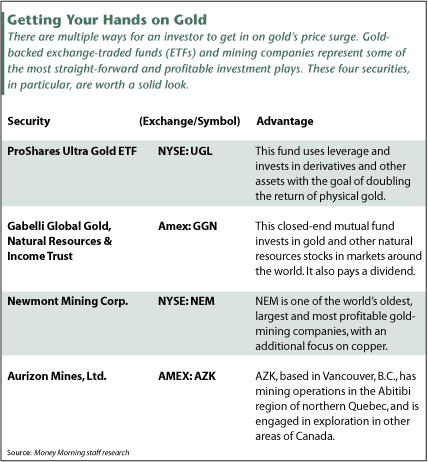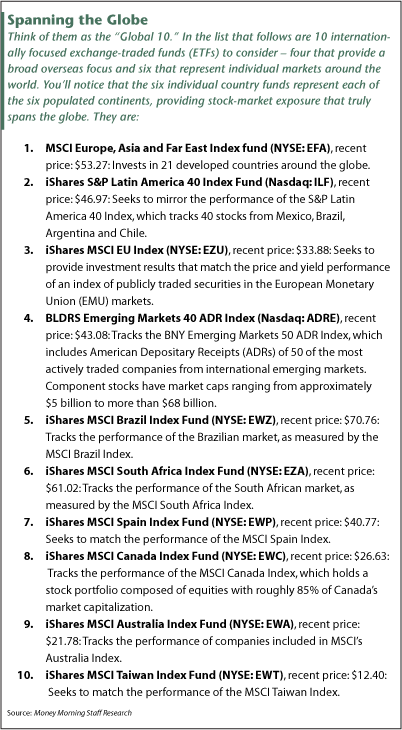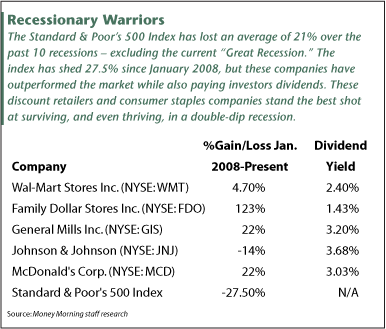The last time the U.S. economy suffered through a double-dip recession, this country was struggling to overcome the fallout from an Arab oil embargo, Vietnam War-era deficits, and an inflationary spiral that just wouldn't let go.
That 1981-82 double-dip downturn - the result of an economic "shock treatment" aimed at curing those ills - consisted of two recessions that were separated by a single quarter of growth.
The current backdrop is very different from the one that was in place back then, but the threat of a double-dip recession is no less real. Indeed, with each passing week, and with every new economic report that comes out, the possibility that the U.S. economy will backslide into a double-dip recession seems to become more of a probability - or even a likelihood.
If nothing else, it's time to take precautions. And there are three easy ways an investor can brace for a double-dip recession. Simply put:
Step I: Buy Gold.
Step II: Go Global.
Step III: Acquire U.S. stocks that are "recession proof."
Step One: Buy Gold
Face it, the U.S. dollar is in deep trouble.
The anemic economy recovery has forced the Fed to continue its stimulus measures at the expense of the greenback. The Fed's latest announcement - that it would reinvest the proceeds from expiring mortgage-backed securities into longer-term U.S. Treasuries - is just the latest piece of evidence that the dollar is doomed.
In fact, the consumer price index (CPI) rose 0.3% in July, it's first increase in four months, and a move that signals a marked shift in inflationary expectations. Producer prices rose 0.2% for the month.
In the long run, given the recent actions of spendthrift governments like that of the United States, inflation is the likeliest possible outcome. And gold offers investors a tangible asset that has inherent value, compared to a fiat currency that's only as good as the word of the government that issued it.
There are numerous ways an investor can stock up on the yellow metal - the most straightforward of which is to own coins or bullion.
"There's nothing like holding a gold coin or gold bar in your hands. This is the oldest and most direct form of gold ownership," said Peter Krauth, a well-known commodities expert who is also the editor of the Global Resource Alert. "Bullion dealers are the easiest way for most investors to buy smaller quantities of gold. Do some homework to check them out before you buy."
Most dealers charge premiums of about 3% to 6% above the "spot" price for physical gold. But you'll pay much more if you wait for the economy to tank before stocking up.

"When things get hairy - as they were back in November 2008, in the depths of the global financial crisis - premiums can go up by three to five times, with some dealers charging 10% to 15% above spot," says Krauth. "Obviously, you'll be better off buying gold on price dips and under calmer circumstances."
Depending on your situation, gold exchange-traded funds (ETFs) may be a more practical way of gaining exposure to the gold market. But remember, ETFs don't give you gold, per se; they give you a claim on gold. It's not quite as safe as owning physical bullion, but it's a whole lot better than nothing - and you don't have to worry about shipping or storage.
One of the easiest ways to buy such a claim on gold is through the SPDR Gold Trust ETF (NYSE: GLD). With a total value of $50 billion, GLD is now the largest physically backed gold ETF in the world, holding 1,300 metric tons (or 42 million ounces) of the yellow metal in a London vault. GLD shares, which represent one-tenth of a gold ounce, can easily be bought and sold by investors through their brokerage account.
Another option to acquire paper gold is through Perth Mint Certificates (PMC). Locked away in a vault and insured, this is the only bullion-storage program that is government-backed, with the state of Western Australia standing firmly behind it.
You'll need to commit at least $10,000 to get started in PMCs. There are also small-but-reasonable fees to obtain your certificate and trade your holdings. It's also a great way to gain some international diversification for your gold holdings, by owning it outside of your home country. For more information, go to Perthmint.com (note that Kitco and Asset Strategies also offer the PMCs).
Action to Take: Gold is one of the best ways to add some protection to your portfolio. And, for a limited time, there is one Canadian mining company that is actually giving gold away - for free. There's no catch either. To find out how you can claim your fair share, go here.
Step 2: Go Global
One of the best ways to sidestep economic turmoil in the United States is to increase your exposure abroad. Let your investments do some traveling, by investing in countries that have less debt, more balanced budgets, generally pro-business policies, and a substantial cache of natural resources.
We're talking about China, Brazil, and Canada, among others. These countries are raising interest rates and curtailing lending while U.S. policymakers are still working overtime to fuel growth with government spending and near-zero interest rates.
Consider Canada, for example. For a long time that country was dependent on U.S. industry for jobs, but our northern neighbor has suddenly come into its own.
While high unemployment continues to hamstring the U.S. economy, Canada already has recouped 403,000 jobs, or 97% of those lost in the recession. Canada's national unemployment rate stands at 8%, compared to 9.5% in the United States.

The Bank of Canada raised its benchmark-lending rate to 0.75% in July, making Canada the first Group of Seven (G7) nation to raise interest rates. The International Monetary Fund (IMF) recently said that Canada is likely to be the first of the seven major industrialized democracies to return to a budgetary surplus status by 2015.
The country also has a sound banking sector that wasn't taken in by the untrustworthy assets that brought down U.S. financials.
"Canada largely sidestepped the entire global financial crisis of the past four years because its highly regulated banks were prohibited from securitizing mortgage debt to the extent that was widely practiced in the United States," said Money Morning Contributing Writer Jon D. Markman. "Canada's banks also were banned from taking on high levels of leverage to make larger and riskier loans. Suddenly, Canada is being held up as a shining light of sobriety, daring, common sense, and strong returns."
The Royal Bank of Canada (NYSE: RY) and Potash Corp. (NYSE: POT) are two strong options. In fact, Potash stock surged more than 30% after Australian mining giant BHP Billiton Ltd. (NYSE ADR: BHP) offered to buy the company for $38.56 billion .
Also consider Australia and Brazil, which have economies that are very similar to Canada's. All three countries are commodity-rich and fiscally sound. Australia's benchmark interest rate stands at 4.5% and Brazil's at 10.75%. And they all have very vibrant mining sectors.
Brazil and Australia are the world's two largest producers of iron ore - the key ingredient in making steel. And while Australia has rich deposits of coal to fuel energy consumption, Brazil has large deposits of oil lying just off its shores.
You would do well to gain exposure either to Brazil's Vale (NYSE ADR: VALE) or Australia's Rio Tinto PLC (NYSE ADR: RTP) - two of the world's largest iron ore producers.
Petroleo Brasileiro SA (NYSE ADR: PBR) would get you access to Brazil's burgeoning oil industry. And if you're looking for a more balanced play, you can find it in the iShares MSCI Brazil exchange-traded fund (NYSE: EWZ).
In addition to applying sound domestic policies, Canada, Australia, and Brazil also have benefited from rapid growth in the Far East, especially China.
China has some $2 trillion in foreign exchange reserves, a fast-growing consumer class, and scorching economic growth to match. Its economy expanded by 11.9% in the first three months of the year and by 10.3% in the second-quarter. And the only reason growth decelerated is because the central government deliberately curbed lending to prevent the economy from overheating. Now that it's accomplished its goal, Beijing will almost certainly take its foot off the brake.
"Chinese stocks are definitely going to be fairly volatile in the coming months, if only because the markets are still relatively immature and the government is going to keep a very careful watch on them to keep growth in check," said Money Morning's Chief Investment Strategist Keith Fitz-Gerald. "However, there will be plenty of bullish pressure on prices because the money that's been targeting real estate speculation - now blocked by the government restrictions - will be channeled into stocks."
Of course, China isn't the only red-hot economy in Asia. In fact, Money Morning Contributing Editor Martin Hutchinson is very high on South Korea. South Korea's GDP was up 7.2% year-over-year in the second quarter, after surging 8.2% in the first three months of 2010.
Action to Take: If you're not sure where to start investing, take a look at this opportunity to profit from China's security conscious society. China is building a high-tech police state with one billion surveillance cameras! So we want to own the company due to get 70% of the contracts. In 2007 their stock hit $30 in pre-Olympics frenzy, then dropped to $3.75. Now we've uncovered a new "buy" signal. We see it's market cap skyrocketing to $5 billion... for a 1,000% potential gain! Find out more here.
Step 3: Acquire "Recession Proof" U.S. Stocks
To be clear, no stock is 100%-guaranteed to be recession-proof. What we're talking about are stocks that tend to benefit in times of economic uncertainty and discord. That includes low-cost retailers, utility companies, healthcare companies, and most of all, companies that pay dividends.
For instance, Wal-Mart Stores Inc. (NYSE: WMT), Family Dollar Stores Inc. (NYSE: FDO), Amgen Inc. (Nasdaq: AMGN), Celgene Corp. (Nasdaq: CELG), and Southwestern Energy Co. (NYSE: SWN), were some of the market's top performers in 2008.
However, rather than concentrate on specific sectors, investors would be better served to consider buying stocks that have a long history of success, reliable dividend payouts, and global diversification.
Indeed, low-cost retailers and consumer staples companies are usually the safest bets in tough economic times, because consumers tend to cut back discretionary spending. Instead, they bargain hunt for the bare necessities - and investors should do the same.
In fact, Wal-Mart and Family Dollar were among the highest rising stocks in 2008. WMT rose 15.63% that year and FDO surged 23.14% -- the biggest percentage gain among companies listed on the Standard & Poor's 500 Index.
Family Dollar has proven to be the biggest winner, as it's up more than 129% since Jan. 4, 2008. The stock has seen a huge surge in volume in recent weeks, as many analysts upgraded the holding in light of the deteriorating economy.
Conversely, shares of Wal-Mart have struggled lately, but analysts say that only makes them a more compelling buy.
Wal-Mart stock is down more than 5% year-to-date, and recently hit a one-year low of $47.77.
"Wal-Mart under $50 is cheap," said Jeffrey Saut, chief investment strategist at Raymond James. "It's being valued like a grocery store even though 50% of its revenue comes from non-grocery items."

Wal-Mart also is a global brand, which means it's not entirely reliant on the U.S. consumer. Wal-Mart currently operates in 15 countries, with just under half of its 8,300 stores located outside of the United States. International sales last year topped $100 billion for the first time ever, rising to about one-quarter of the company's gross intake.
Johnson & Johnson (NYSE: JNJ) and General Mills Inc. (NYSE: GIS) are also good candidates. General Mills is up 21% since the start of 2008. Johnson & Johnson is down about 13% in that time but still ahead of the S&P 500, which is down 27%.
Both pay sizeable dividends with GIS yielding 3.2% and JNJ yielding 3.7%.
"JNJ has a sound business model that emphasizes the development and marketing of top quality drugs and benchmark consumer products," says Money Morning Contributing Editor Horacio Marquez. "Its strong and stable profit margins - with gross profit north of 70% - and its consistent growth over more than a century are matched by only a handful of companies."
Like Wal-Mart, JNJ benefited from strong international sales growth. Domestic sales declined 2.8%, while international sales increased 4.1%. That will bode well for the company should the dollar become weaker and its products less expensive in foreign countries.
"I believe that 2010 will bring a 7% sales increase as sales and profits will be helped by the weak dollar, which will give sales abroad a boost," says Marquez.
Action to Take: Whether the economy takes a "double dip" into recession or not, if there's one thing we've all learned in the last two years, it's that we could all benefit from some portfolio protection. Lone investor's don't stand a chance anymore... unless you buy the same "insurance" every Wall Street trader buys to profit hugely no matter which way the market goes. We call it "Financial Kevlar"... and you can get it here.


